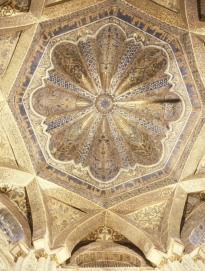Table of Contents
The sets of elements analyzed above all are linear in arrangement. Circular arrangements, without endpoints, can be viewed as looped linear arrangements.

Figure 1. Cordoba, Great Mosque, dome in front of the mihrab.
The octagonal center of the mosaic-encrusted dome in front of the mihrab of the Great Mosque of Cordoba is filled with eight gores separated by ribs. These eight gores carry four somewhat different foliate designs, each design repeated in the opposite gore (ignoring a few very small differences, and assuming that restoration has respected the original designs). The arrangement of decoration in the gores may be linearized and diagrammed so:
A B C D A B C D
In this view of the arrangement the apparent symmetry, adjusting for the finite number of elements, is a symmetry of translation (of one of the sequences A B C D to the other). A better representation, indicating an unlinearized analysis, might be
> A B C D A B C D >
or, of course,
< A B C D A B C D <
In this analysis (accepting the circular and even domical shape of the arrangement) there is no symmetry of reflection, but one symmetry of rotation (around the center, at 180°); it may be called “variation in coördinate detail with rotation”. In this case rotation is analogous to translation because of the patterns within the regular outline of the gored dome.
The interested reader may wish to consult the excellent photographs in Henri Stern's study of the mosaics to consider other elements of the dome; note that the intersecting ribs are decorated with two distinct patterns that group them into two interpenetrating squares.1
The interior of the dome of the Mausoleum of Shād-i Mulk Aqā, Samarqand (773–85/1371–83), the exterior socle of which I discussed above, has decorative fields arranged similarly to the dome in front of the mihrab of the Great Mosque of Cordoba, except that there are only three patterns.2 The tile interior of the dome is divided by a framework into eight panels with the arrangement
> A B A C A B A C >
which has one symmetry of rotation (180° around the center) and eight symmetries of reflection (along the eight axes bisecting and dividing the eight panels). The A pattern occurs in the center of the dome, and I wonder whether the A (or the B and C) panels were meant to seem "solid" against an “open” framework with the other panels seeming “open”, as if to the sky.
The Mārinid openwork ribbed dome in front of the mihrab of the Great Mosque of Tāzā (probably 691/1292), unlike its prototype in the Great Mosque of Tilimsān, has varied ornament in the arch-outlined lower sections of its sixteen divisions.3 The four axial sections bear inscriptions. The eight sections flanking them are all decorated with the same arabesque design. The remaining four sections carry foliate decoration interlacing with arch forms, again all the same design.
The full set of symmetries of the sections of this arrangement (considering the sections as units, without considering the symmetries of each section by itself) includes symmetries of reflection and rotation, as in the examples above. More symmetries of reflection exist than in an arcade with subsidiary axes of symmetry of reflection in a series of coördinate forms because the design is circular.
In addition, if the circuit of the sections is analyzed as a sequence it becomes analogous to an arcade. Taking the inscribed section in the center of the qiblah side of the dome as the center of the series and representing the section directly across from it twice, the scheme is:
A C B C A C B C A C B C A C B C A
where the C's are the arabesque sections. The same scheme exists, of course, if any of the inscribed or foliate sections is taken as the center element, but the axial, inscribed sections were surely seen as primary. The arrangement as diagrammed above can be seen as an example of subsidiary axes of symmetry of reflection in a series of coördinate forms, but in the circular arrangement of the sections no A is either a major or minor axis; nevertheless, if the A's are considered to be primary, the B's are secondary and may be thought of as subsidiary axes.
1. Stern, op. cit., pp. 28–33. Stern noted no restoration in the dome's mosaics.
2. Cohn-Wiener, op. cit., pl. 34; Golombek and Wilber, op. cit., pl. 25; G.A. Pugachenkova, A Museum in the Open, Tashkent, 1981, fig. 100 for the interior of the dome in color.
3. Henri Terrasse, La grande mosqueée de Taza, Paris, 1953, pp. 36–47, pl. 48, 49. Terrasse noted that some of these sections are restorations; I assume that restoration has preserved the original variation of design.